In her work, Kit reminds me of the form in the book. ‘Form’ is usually the first object that a complainer encounters. And sometimes it’s the last chance to explain what happened to the complainant. Eventually, at the end of this process, the paper will become a “separated body” and a separate voice, just like the kit in the work of Eliza Schvartz. How is this form being written, which has already been handed over to the institution and is part of an indelible complainer? Can this form properly capture me and my complaints?
Mainly in form, blank spaces had to be filled in an orderly way. which is compulsory. There is no space for ambiguity. After the form was filled out, every case looked flawless and clear. Becoming flawless and simple means that the case is separated from the complainer’s body and voice. Every word from the complaint is separated from the complaint itself.
Let’s go back to the cord, now the meaning of cord could be expanded to form. If you look at the whole process of complaining as a process of weaving a cord, the form should be an important document that distinguishes my cord from others. It should be the only piece of paper that describes my cord.
The ‘form’ could be the life-ring at the end of the cord. When we throw the life ring, it should be the one we can trust and grab. If we already know the end of the form could be the cabinet, then at least we need something more than a case number and boring documentation. At some point, I started to question why we cannot make a more relevant or striking form. The form should not be intended to define clear normative principles. Rather should have the intention of finding ambiguity and contradiction in each case.
So I want to build a form that would allow for ambiguity. For amplifying the complaint, I feel the necessity to re-design the form. Making a form for the complaint could be challenging since every case has different shapes and voices. Maybe the idea of “form” which already has a meaning of “uniform” would not be a perfect way of “hearing” the voice. However, if we agree with the necessity of compiling the complaint’s narrative as a testimony and being a catalyst from hereafter, and not only as a piece of evidence but also as a “discrete body”, I reckon we all agree to the making better form.







